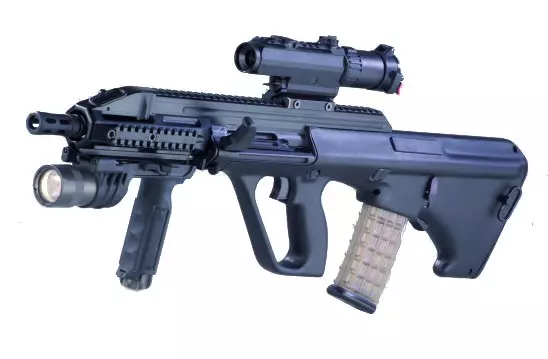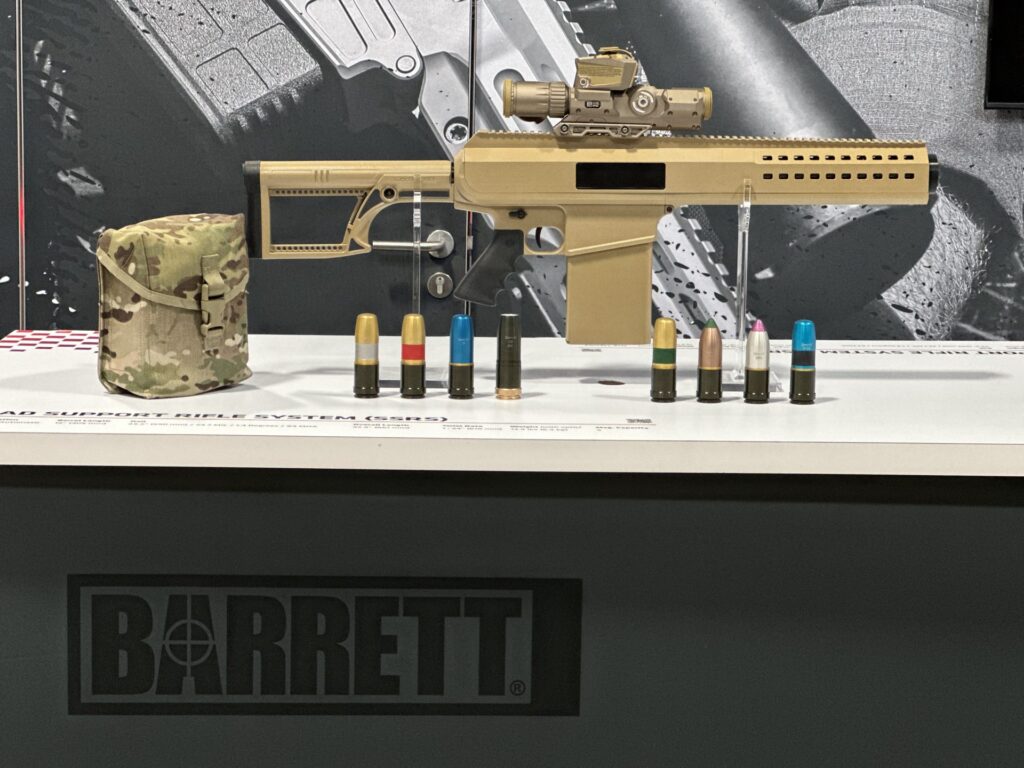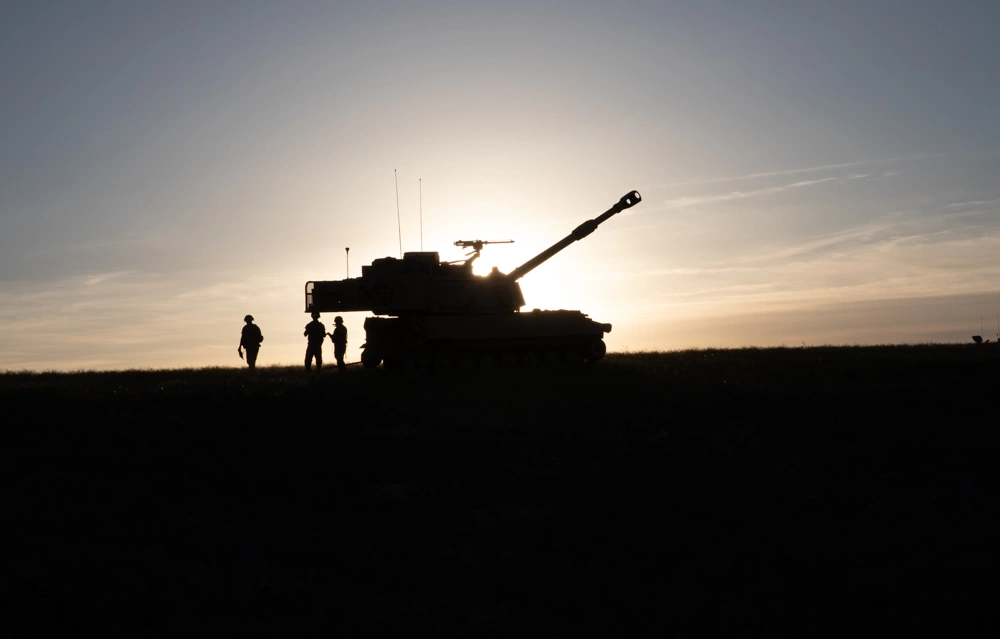The adaptable Steyr AUG – Service rifles from around the world
- By Travis Pike
Share This Article

Good old Ireland, I appreciate your beers, accents, and folklore. I also have a great appreciation for your choice of service rifle. The Irish Defence Forces are a modest military force with a long-standing policy of neutrality but also a long history of serving in missions on behalf of NATO. Their current service rifle is the Steyr AUG Mod 14, a fascinating and successful bullpup assault rifle.
The Steyr AUG
In 2022 the AUG looks high-tech and futuristic so imagine what people thought in 1977 when the gun premiered. The Steyr AUG is a bullpup. This means the action and magazine are set behind the trigger. The benefit of this layout is a significantly shorter design that features a full-length barrel. The Steyr AUG is the size of a short-barreled carbine, and the Irish variant has an overall length of 31.1 inches. The barrel length is still 20 inches long, but it’s shorter than an M4 with its stock deployed.

The Steyr AUG fires the NATO standard 5.56 caliber round which is designed to be fired from a 20-inch barrel. Mixing a 20-inch barrel with a 5.56 caliber round grants you the most range and velocity and forms a very comfortable, low-recoil weapon.
The AUG uses a short-stroke gas piston system that’s proven, reliable, and very effective with short and long barrels. If one wants to toss a suppressor on the AUG, they wouldn’t have reliability issues.
The AUG uses a progressive trigger system. A progressive trigger contains two firing modes within one trigger pull. A short pull results in a semi-auto shot, and a longer pull results in full auto fire.
The Irish Service rifle is the rifle variant, but the AUG is a modular rifle designed to be easy to set up in various configurations. This includes a light machine gun variant, an SMG variant, a carbine with a 16-inch barrel, and even a DMR variant for enhanced accuracy. The AUG has always been well ahead of the curve in design. Swapping configurations takes no effort and can be done very easily and quickly.
Related: How the M16 rifle gave birth to the M4 carbine
The Irish AUG

The Irish Steyr AUG Mod 14 has an interesting combination of features resulting in a modern AUG variant.
The weapon’s modular design allowed the Irish Defence Forces to modernize their weapons without fully replacing them. The MOD 14 uses a standard stock system from the original rifles but is fitted with an A3 receiver group.
This group ditches the 1.5 fixed optical sights and replaces them with a Picatinny rail, allowing the Irish military to mount modern optics to their weapon system. In a day and age where thermals and night vision exist, this can be invaluable when the fight comes at night.
The Irish also use an automatic lockout (ALO) trigger. This device fits the weapon’s trigger with a small projection that must be pressed to engage the progressive trigger for automatic fire. Things might get tense in a firefight, and the progressive trigger might be pulled to full auto mistakenly. The ALO device prevents this from happening and makes it simple to prevent accidental full auto fire.
Related: The FN Evolys – Carving its spot in the machine gun world
The Accessories

The standard optic of the Irish Defense Forces is the Trijicon ACOG. The same style of optic is used by the United States Marine Corps. This is a fixed power optic with a 4X power magnification. The optic gathers external light to power an internal reticle.
The optic also comes with a bullet drop compensator. The compensator allows the shooter to quickly and automatically compensate for long-range shots.
Even with the short optic in place, there is plenty of room for adding lasers, lights, and whatever else a shooter needs.
The Irish use Diemaco M203 grenade launchers for their grenadiers. These weapons mount to the bottom of their rifles and allow a grenadier to launch 40mm grenades out to 350 meters. A 40mm grenade launcher is a force multiplier in a firefight.
Related: This is the fascinating history of grenadiers, a centuries-old elite unit
The magazine

While the Irish and the AUG use the NATO standard 5.56 caliber round, the magazine is a bit different. Steyr makes a NATO variant that uses STANAG magazines. However, the standard AUG uses a proprietary magazine made from polymer which is an early example of a successful polymer magazine.
This magazine comes in either 30- or 42-round magazine capacities. The 42-round seems to be the favored option, and who wouldn’t want more capacity rather than less? The Steyr AUG magazine is also transparent, allowing the user to gauge how much ammo they have left with a quick glance.
The AUG magazines have always been reliable, well-proven, and designed to last. They’ve fought off STANAG adoption for so long for a reason.
Grand old Ireland
The Irish Defence Forces has been wielding the Steyr AUG since the late 1980s. It’s been a very capable weapon for them, and the modular nature of the design allows it to adapt to the modern needs of a fighting force.
The Steyr AUG is one of the most successful bullpup rifles ever made.
Read more from Sandboxx News
- Beretta ARX 160 – Service rifles from around the world
- Letters to Loretta: Surviving through the brutal German winter
- Savage 1861 Navy – An oddball pistol in Union service
- How Ukrainian soldiers are using drones to fight Russians on the ground
- The Air Force wants to accelerate the development of autonomous technology for its fleet
Related Posts
Sandboxx News Merch
-

‘AirPower’ Classic Hoodie
$46.00 – $48.00 Select options This product has multiple variants. The options may be chosen on the product page -

‘Sandboxx News’ Trucker Cap
$27.00 Select options This product has multiple variants. The options may be chosen on the product page -

‘Kinetic Diplomacy’ Bumper Sticker (Black)
$8.00 Add to cart

Travis Pike
Travis Pike is a former Marine Machine gunner who served with 2nd Bn 2nd Marines for 5 years. He deployed in 2009 to Afghanistan and again in 2011 with the 22nd MEU(SOC) during a record-setting 11 months at sea. He’s trained with the Romanian Army, the Spanish Marines, the Emirate Marines, and the Afghan National Army. He serves as an NRA certified pistol instructor and teaches concealed carry classes.
Related to: Gear & Tech

The Switchblade, loitering munitions, and the new terrifying face of warfare

5 ways to prepare and survive the Marine Corps boot camp

Barrett’s Squad Support Rifle System will make infantry squad deadlier

The unique world and uses of howitzers
Sandboxx News
-

‘Sandboxx News’ Trucker Cap
$27.00 Select options This product has multiple variants. The options may be chosen on the product page -

‘AirPower’ Classic Hoodie
$46.00 – $48.00 Select options This product has multiple variants. The options may be chosen on the product page -

‘AirPower’ Golf Rope Hat
$31.00 Select options This product has multiple variants. The options may be chosen on the product page -

‘Sandboxx News’ Dad Hat
$27.00 Select options This product has multiple variants. The options may be chosen on the product page
